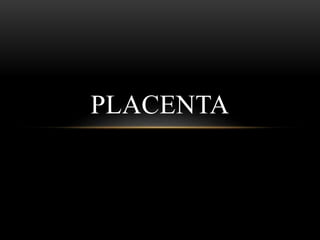
Placenta
- 1. PLACENTA
- 2. PLACENTAThe placenta is a temporary organ that connects the developing foetus via the umbilical cord to the uterine wall to allow nutrient uptake, thermo-regulation, waste elimination, and gas exchange via the mother's blood supply; to fight against internal infection; and to produce hormones which support pregnancy. The placenta functions as a fetomaternal organ with two components: the fetal placenta which -
- 3. develops from the same blastocyst that forms the fetus, and the maternal placenta , which develops from the maternal uterine tissue. The placenta is expelled from the body upon birth of the fetus.
- 4. Anatomy • Circular disc with a diameter of 15-20 cm and thickness of about 2.5 cm at its center. • It feels spongy and weight about 500 gm. • It presents two surfaces, fetal , maternal and peripheral margin.
- 5. FETAL SURFACE (Chorionic Plate) : • Covered by the smooth and glistening amnion with the umbilical cord attached at or near its center. • Branches of the umbilical vessels are visible beneath the amnion. • The amnion can be peeled off from the underlying chorion except at the insertion of the cord. • At term, about four-fifths of the placenta is of fetal origin.
- 6. MATERNAL SURFACE : • Rough and spongy• Dull red colour• A thin greyish, layer which is the remnant of decidua basalis (compact and spongy layer). • Maternal surface mapped out into 15-20 convex polygonal areas known as lobes or cotyledons which are limited by fissures. • Each fissure is occupied by the decidual septum. • Only the Decidua basalis and Blood in the intervillous space are of Maternal origin.
- 7. MARGIN : • Peripheral margin of the placenta is limited by the fused basal and chorionic plates. • Essentially, the chorion and the placenta are one structure but the placenta is a specialized part of the chorion.
- 8. Foetal surface of placenta showing attachment of the umbilical cord with ramification of the umbilical vessels. Maternal surface of the placenta showing shaggy look with cotyledons limited by fissures.
- 9. STRUCTURES : • Placenta consist of 2 plates, i) Chorionic Plate – • Lies internally, lined by amniotic membrane. • Umbilical cord is attached to this plate. • it consists of – i. Primitive mesenchymal tissue containing branches of umbilical vessels ii. A layer of cytotrophoblast and iii. Syncytiotrophoblast.
- 10. ii) BASAL PLATE • It Lies to Maternal aspect. • It consists of the following structures from outside inwards. i. Part of the compact and spongy layer of the decidua basalis ii. Nitabuchs layer of fibrinoid degeneration of the outer syncytiotrophoblast at the junction of the cytotrophoblastic shell and decidua. iii. Cytotrophoblastic shell iv. Syncytiotrophoblast.
- 12. DEVELOPMENT OF PLACENTA • Developed from two sources.• The principal component is fetal which develops from the chorion frondosum and the maternal component consists of decidua basalis. • When the Interstitial implantation is completed on 11th day, the blastocyst is surrounded on all sides by lacunar spaces. • Stem villi developed on13th day which connect the chorionic plate with the basal plate.
- 13. • Primary, secondary and tertiary villi are successively developed from the stem villi. • Arterio-capillary-venous system in the mesenchymal core of each villus is completed on 21st day. • Simultaneously, lacunar spaces become confluent with one another by 3rd – 4th week and form a multilocular receptacle. • Chorion frondosum and decidua basalis form the discrete placenta. It begins at 6th week and is completed by 12th week.
- 14. • Until end of 16th week placenta grows both in thickness and circumference due to the growth of chorionic villi with accompanying expansion of the intervillous space.
- 16. PLACENTAL FUNCTIONS : The main functions of Placenta are – • Transfer of nutrients and waste products between the mother and foetus • Endocrine Function – Placenta is an endocrine gland , it produces both steroid and peptide hormones to maintain pregnancy. • Barrier Function – The Fetal membrane has long been considered as the protective barrier to the foetus against noxious agents circulating in the maternal blood.
- 17. • Respiratory Function Although the fetal respiratory movements are observed as early as 11 weeks, there is no gaseous exchange. Intake of oxygen and carbon dioxide take place by simple diffusion across the fetal membrane. • Excretory Function Waste products from the foetus such as urea, uric acid and creatinine are excreted in the maternal blood by simple diffusion. • Nutritive Function The foetus obtain its nutrients from the Maternal blood and when the diet is inadequate, then only depletion of maternal tissue storage occurs.